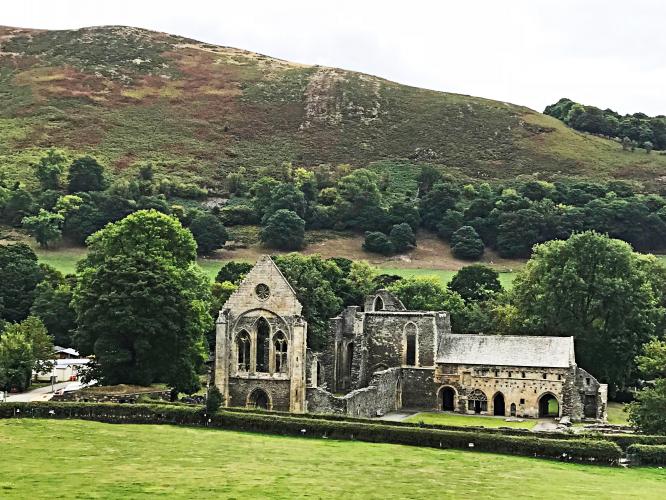![Cycling Horseshoe Pass Climbing Horseshoe Pass by Bike - aerial view of Llangollen Bridge, old stone bridge with 3 arches, river passing through, dense foliage in and around river, Simon Warren's 100 Greatest Cycling Climbs #90 Logo]()
The ancient Llangollen Bridge 700 meters from start of climb.
Horseshoe Pass (in Welch Bwlch yr Oernant) has hosted the British National Hill Climb Championships in 1971 (John Clewarth) and 1981 (Jeff Williams).
![Cycling Horseshoe Pass Climbing Horseshoe Pass by Bike - photo collage, road sign for 20% Grade, road sign for Bwlch Yr Oernant/Horseshoe Pass, ancient abbey ruins within green pasture at base of hillside, bike leaning against red phone booth on side of road]()
Valle Crucis Abbey at 400 m (bottom right).
We begin this climb soon after passing over the wonderful LLangollen Bridge. At about 400 meters into the climb we come in sight of the 13th century Valle Crucis Abbey.
“Valle Crucis Abbey (Valley of the Cross) is a Cistercian abbey located in Llantysilio in Denbighshire, Wales. More formally the Abbey Church of the Blessed Virgin Mary, Valle Crucis it is known in Welsh both as Abaty Glyn Egwestl and Abaty Glyn y Groes. The abbey was built in 1201 by Madog ap Gruffydd Maelor, Prince of Powys Fadog. Valle Crucis was dissolved in 1537 during the Dissolution of the Monasteries, and subsequently fell into serious disrepair. The building is now a ruin, though large parts of the original structure still survive. Valle Crucis Abbey is now under the care of Cadw.” Wikipedia - Valle Crucis Abbey.
![Cycling Horseshoe Pass Climbing Horseshoe Pass by bike - photo collage, distant view of road carved along green hillside, three flags for Britain, two-lane tree-lined road, red sign on side of road reading "No Cats Eyes", sign for Britannia inn, PJAMM Cycling logo]()
At kilometer 1.7 we pass the 550 year old Britannia Inn (center).
The climbs namesake “Horseshoe” (Welch name is Bwlch yr Oernant) is at kilometer 4.1 just after the 20% grade sign.
![Cycling Horseshoe Pass Climbing Horseshoe Pass by bike - bike parked along two-lane roadway leaning against road sign for 20% grade, PJAMM cycling jersey draped across bike, green rolling hillsides and grey cloudy skies]()
Just before the horseshoe.
![Cycling Horseshoe Pass Climbing Horseshoe Pass by bike - distant view of road carved along side of hill covered in green shrubbery]()
Looking back half-way through horseshoe at km 4.5.
![Cycling Horseshoe Pass Climbing Horseshoe Pass by bike - photo collage, various views of the Llangollen bridge, road signs, aerial views of river]()
Llangollen Bridge.
![]()
Steepest kilometer begins at km 1.3(11.4%).
Top things to do in Llangollen.
CyclingUphill.com:
“Horseshoe pass (Bwlch yr Oernant) is a 4 mile climb in North Wales near Wrexham, averaging 5% – climbing 311 metres to finish at 1,200 ft (404m). It’s a challenging hill climb, with a few steeper sections of up to 12%. On a good day, it provides a beautiful backdrop for a hill climb..
As it name suggests, there is a 180 degree horseshoe curve towards the top. This means that you can see the road snaking up above you as you climb. It also means you’re likely to face a mixture of headwinds and tailwinds on different parts of the climb. . . .
Fairly soon after the start of the climb, there is the steepest section of perhaps 12%. This is within a wooded area so is relatively sheltered from the wind. You want to go as hard as you can without blowing up for the remaining couple of miles. I took most of the climb seated down, only briefly getting out of the saddle for a short 12 % section in the trees. Then it was head down, and try and maintain the pace. After the wooded section the gradient eased off, but here there seemed to be a strong headwind for a considerable straight section. I was relieved to reach the horseshoe and begin the long bend around the ‘horseshoe’.” More

 We've partnered with Sherpa-Map.com to bring you the best route planning tool. With a PRO Membership you can use this climb as a reference when creating your route.
We've partnered with Sherpa-Map.com to bring you the best route planning tool. With a PRO Membership you can use this climb as a reference when creating your route. 

